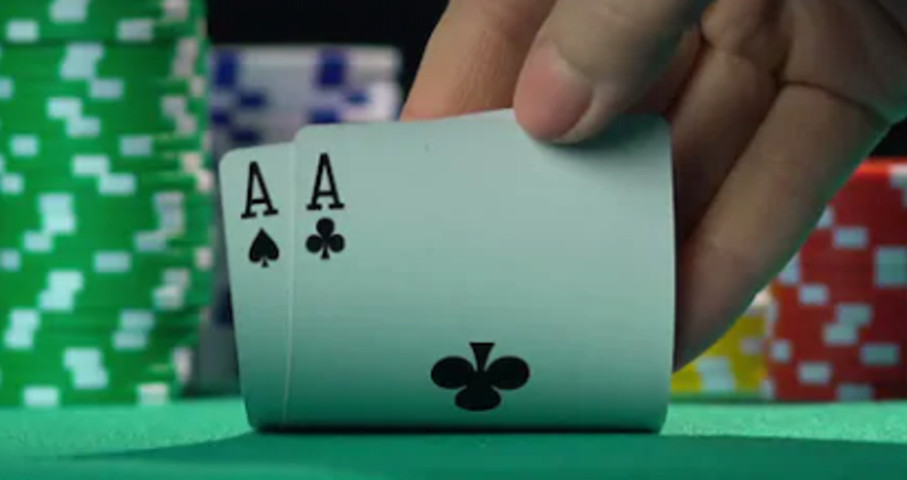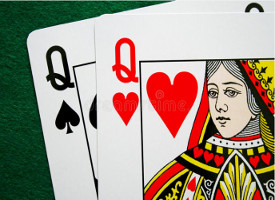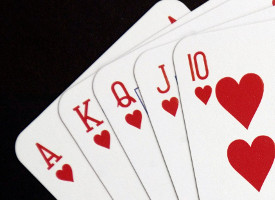What Are Good Starting Hands in Texas Hold’em?
You pick up the cards you’ve been dealt at the start of a round of Texas Hold’em.
Immediately, you feel a jolt of excitement. One of the cards is an ace. But the other is a 2. When it is your turn to decide whether or not to fold, you find yourself scrambling to make a decision. The 2 is pretty worthless, but the ace is hard to let go of. What should you do?

As you’re about to read, this just may be the best starting hand there is!
As a poker newbie, it can be hard to recognize a good hand from a bad one. If you have been flying by the seat of your pants to this point, you probably have played a whole lot of hands that more experienced players would have folded.
In this guide, we’re going to help you learn more about how to objectively evaluate a starting hand in Texas Hold’em. That way, you can make a more informed decision about whether to play a hand or not when one or more of your cards is tempting.
Categories of Starting Hands
A good first step to evaluating the potential worth of a Texas Hold’em starting hand is to figure out which category of starting hands it belongs to. This is easy, as there are only five of them.
- Pairs
Pairs, by definition, can never be suited, as there is only one of each card value in each of the four suits. You can have a 3 of clubs and a 3 of spades, or a 3 of spades and a 3 of diamonds, but you cannot have two 3 of clubs or two 3 of spades together (if you do, something is seriously wrong with the deck you are using).
- Unsuited Connected Cards
These are cards which are numerically adjacent to one another, but do not share a suit. Some examples might be a 4 of spades and a 5 of clubs, or a 9 of diamonds and a 10 of hearts.
- Suited Connected Cards
These are cards which are both numerically consecutive and share a suit. Examples would include a 4 of spades and a 5 of spades, or a 9 of diamonds and a 10 of diamonds.
- Unsuited Unconnected Cards
These are cards which are neither numerically adjacent to each other nor belong to the same suit. Some examples could include a 3 of spades and a 5 of hearts, or a 4 of clubs and a queen of hearts.
- Suited Unconnected Cards
These are card which are not numerically consecutive, but which do share a suit. Examples might include a 3 of spades and a 5 of spades, or a 4 of clubs and a queen of clubs.
In general, there are some categories here that you want to pay close attention to.
For example, a pair is notable, because the odds of drawing any pair at all are 16 to 1. And the higher you climb up the ranks, the less likely it is to draw that particular pair or better. For example, your odds of drawing a pair of queens or a pair of higher ranked cards are only 73 to 1. Your odds of drawing a specific pair are 220 to 1.
Plus, you alone know that two of the four cards of that rank are accounted for.
So, even a small pocket pair (defined as pairs ranging up to two sixes) can be valuable. The best case scenario would be, for example, when a matching card appears on the flop.
This kind of hand is great not just because you have three of a kind at that point, but because it is unlikely anyone else at the table thinks you do.
Note that with a small pocket pair, your implied odds are good, but your pot odds are poor.
Obviously, higher pairs are safer to play.
Moving along, the qualities of cards being suited and/or being connected are both valuable for obvious reasons.
If you are dealt suited cards, you may have a chance at a flush, and if you are dealt connected cards, you might have a shot at a straight.
That being said, your chances of flopping a flush are only 0.8%.
What about cards which are unconnected? The further apart they are from each other, the less likely they are to produce the desired straight.
So, with all of that in mind, let’s look at some top starting hands as well as some commonly overvalued starting hands.
Also, make sure you also check out What You Need to Know About Bluffing in Poker!
Best Starting Hands in Texas Hold’em
Following are some hands which are definitely worth getting excited about having been dealt.
AA
A nickname for a pair of aces is “pocket rockets”. It is without dispute the best starting hand you can receive. There is no higher ranking of cards, and you have two of them.
Now, something important to keep in mind in general—but especially with seductive hands like this one, is that there is no hand that guarantees you are going to win, even if it is the single best starting hand possible like this one.
If, at the showdown, you are still holding nothing better than a pair of aces, someone else could beat you with two pair or anything higher.
For you to have two pair, one of the pairs would have to be in the community cards. But someone else might hold two pair without any pairs being visible on the table.
So, never assume you are invincible. Never stop trying to figure out what your opponents might have.
KK
The next most competitive starting hand is a pair of kings. This makes sense, being as it is another pair, and K ranks right under A.
Now, this is a really good hand, but be aware that it can fall flat fast on the flop. If you see an ace in the community cards, another player could beat your pair of kings with a pair of aces, if they only happen to have one.

Might not be the best starting hand, but it sure is up there!
Not surprisingly, the next best starting hand that you can end up with is a set of queens. Just as with KK, you need to be wary if you see an ace show up on the flop. But you also need to look out for a king turning up.
Now, as we continue our list, please note that the order in which I have listed these hands is variable, depending on who you ask.
Most people will agree easily enough on AA, KK, and QQ as the top three hands in order of how desirable they are. But after that, there are different schools of thought.
JJ
Not everyone feels that JJ is the fourth best hand, many people put a suited AK in this spot. But I am listing it here for the sake of simplicity.
Once again, JJ is a high pair, and a solid hand. But you need to watch out for aces, kings and queens on the flop.
Suited AK
If you get dealt an ace and a king together which share a suit, it is sometimes called a “big slick” or a “super slick”.
This is the highest set of consecutive cards you can be dealt, giving you a chance at a straight, possibly even an ace high straight.
Because it is a suited set, you also may have a shot at flush. In fact, you could even get a royal flush or a nut flush. Even if you do not end up with any killer hands like these, you could still find yourself with a pair or two pair with high cards.
The thing to be aware of is that a hand like this can go south surprisingly fast on the flop.
It is possible to be dealt an amazing starting hand like this, and to effectively find yourself holding nothing on the flop except an ace high.
You can hold out in the hopes of getting a pair on the turn or river. But you should be aware that not that many hands are actually won with high cards. There is a really good chance someone is going to beat you with a pair.
Suited AQ
The next hand to hope for is an ace and a queen that share a suit. This hand is sometimes called by the corresponding name “little slick”. It might also be referred to as a “big chick”. Like the suited AK, this hand brings ample possibilities, including a royal flush or nut flush. Failing that, you could still get a straight, or you could end up with two pair or a high pair.
The same note of caution that holds true with AK also holds true with AQ. While it may seem like an excellent hand before the flop, that can change after the flop if you are sitting around with nothing better than an ace high.
Suited KQ
The next strong starting hand that you might be dealt is a king and a queen which share the same suit. While you don’t have an ace, you could still end up with a royal flush or another high-ranking hand if an ace turns up on the table. There are also possibilities such as two pair or a high pair.
Suited AJ
Another hand which could lead to a royal flush, a nut flush, or a straight is an ace and jack of the same suit. Such a hand is sometimes called a “blackjack” or an “ajax”. There is a larger gap between the ace and the jack than might feel comfortable, but it isn’t huge, and both are high ranking cards. Once again, a strong two pair could be possible, as could a high pair.
Unsuited AK
While most of the top hands we have discussed should be suited, there are a couple of exceptions, one of which is the unsuited ace and king. The overall benefits of this starting hand are much the same as they are for the suited combination, except, of course, that they do not offer you as strong a possibility of a flush.
TT
Finally, we have what is known as “dimes”, which is a pair of tens. While there are no face cards, this is still a great starting hand, because it is a fairly high pair.
Just by studying this list of starting hands, you should get a pretty good idea what is important, and you might also start getting a feel for what is overvalued (see below).
Commonly Overvalued Hands in Texas Hold’em
Now that we have talked about some of the top hands which you should hope for when you are receiving your cards at the start of Texas Hold’em, let’s talk about a few types of starting hands which newbies tend to overvalue and overplay.
An Ace Plus Any Other Unsuited Low/Mid-Rank Card

Pretty much exactly what we’re all looking for over here!
By far the most tempting card in the entire deck is an ace. And for newbies, it can be a source of confusion when it turns up on its own in conjunction with some other unsuited low- or mid-ranking card.
For example –
- An ace of clubs and a three of spades
- An ace of hearts and a seven of diamonds
The second card is pretty useless, sure, but you see that ace, and you instantly get excited. And maybe you should fold, but it’s so hard to fold an ace!
This hand simply is not that great though. You might consider playing it if other players fold before the flop, but otherwise, you should realize that there is a significant chance that all you’ll have is an ace high.
This hand doesn’t lend itself to a straight or a flush. If you are lucky, another ace will appear on the table, and if you are even luckier, there will also be another card to match your low card. You could get a pair or two pair.
But that is a long shot. This hand just isn’t conducive to a lot of different winning possibilities.
Plus, you don’t know what other players might be holding. If they all call or raise, you should almost certainly fold, because they probably have better starting hands than you do.
A Face Card Plus any Other Unsuited Low/Mid-Rank Card
Only marginally less tempting than the ace is any face card, but particularly a king or queen.
Once again, you might find yourself with a hand like one of these –
- A queen of diamonds and a four of clubs
- A king of spades and a six of hearts
The situation here is exactly like that which we just went over with the ace. You are not lined up for a straight or a flush, and while you have one solid card, there is a very good chance that is all you will have after the flop as well, and it isn’t that often that a high card wins.
Suited Unconnected Low Cards
The chances of getting a flush, in general, aren’t great.
If you are dealt a set of suited, unconnected low cards, you could be tempted to play them. Some examples might be –
- A two of clubs and a seven of clubs
- A three of diamonds and a nine of diamonds
Did you know that you only have a 1 in 118 chance of getting a flush on the flop if you have a starting hand like this?
Many beginners hate the idea of giving up a shot at a flush, but a starting hand like this usually should be folded.
A better starting hand might be something like a four of diamonds and a five of diamonds, or a seven of clubs and an eight of clubs.
At least a hand like this gives you a shot at a straight and not just a flush.
Even a two of clubs and a four of clubs is better than a two of clubs and a seven of clubs, because there is only a small gap between the two cards, but they are so low-ranking that you still probably wouldn’t want to play them.
Think about it. If you do not get a straight or a flush, you’ll be relying on getting a low pair or two pair.
It is better just to fold and wait for a better hand to come along.
A Suited Unconnected High Card and Low Card
What if you get dealt a high card and a low card which share a suit?
For instance, what if you get a hand like one of these –
- An ace of clubs and a three of clubs
- A jack of spades and a four of spades
This is where decision making can get a bit tricky. Obviously, the high card is exciting, and you have a chance at a flush.
At the same time, you know that a flush isn’t that likely, and you don’t have a hand that is likely to result in a straight.
If you consult the power ratings for suited hands (which you should do), you will find that the ace and the three here is actually a significantly stronger hand than the jack and the four.
In fact, the ace and the three is considered a pretty decent (not amazing, but okay) starting hand. The jack and the four is mediocre. Not great, but not terrible.
You should watch what is going on with the other players before the flop, if you are not in the starting position.
Are they folding? Is anyone raising? Your observations can help you make a decision about whether to play or fold.
But I Could Have Won That Hand
One of the most agonizing moments in Texas Hold’em is when you are dealt a questionable starting hand, say, an unsuited ace and a two, you fold it, and then, an ace appears on the table.
You may then watch in horror as another ace shows up. Perhaps even worse, a two will appear, and you will see that you could have had a full house.
All you can think is, “I could have won that hand. I should have stayed in!“
But did you really make a mistake in folding?
Probability speaking, no. You did the right thing. And that is what matters.
The majority of the time, something like this won’t occur. The majority of the time, what you did saved you money.
There are always going to be exceptions. Even things which are very unlikely do occur.
But if you use the unlikely outcome of a situation like this to determine your actions in the future, rather than the odds, you are going to put yourself in a position to lose time and again.
You will play your next unsuited ace and low card, and then you will find yourself holding only an ace high card, or a pair, and someone else will beat you.
Outcomes like this will be far more common than the full house that you missed.
So, try to resist the urge to allow flukes of chance to motivate you to overplay sub-par hands.
Play your strategies based on probabilities along with what is going on with the other players at the same table.
Remember: Don’t Get Caught by the Concorde Fallacy

Wait, wait, wait. This kind of Concorde? Yup. That kind.
One of the hardest things to deal with psychologically is when you have an amazing starting hand, and on the flop, it just falls apart.
When this happens, you may feel a strong temptation to stay in the game, especially if a few other players have folded. It might be down to just you and one other player.
At that point, you’re going to feel like folding is “giving up”. And you may think thoughts like, “Well, I made it this far…”
And then your opponent raises. Now what?
By this point, you are emotionally invested in the hand. You might be financially invested, too, since you could have put a lot of money in the pot to stay in already.
In a situation like this, you may be experiencing the cognitive bias referred to as the “Concorde Fallacy”.
It is also called the “commitment bias”, or “escalation of commitment”, or the “sunk cost fallacy”.
The reason for the name “Concorde Fallacy” goes back to the Concorde airliners which flew from 1976 through 2003.
The Concorde program was an unmitigated financial failure. France and Britain £1.1 billion prior to 1976 to make the program a success—and in doing so, they set high stakes.
But even after the flights began, France and Britain continued to lose money. Concorde airliners weren’t paying off. They were nothing more than a continual drain on the resources of both countries.
Decades went by with no improvements. Still, France and Britain refused to give up. Why?
Their reasons for sticking with Concorde had nothing, ultimately, to do with reason. Giving up on the huge investment was just too painful. And with each passing year, they only got more invested and more averse to letting those sunk costs go.
Eventually, of course, they did, in 2003. But by then, their losses were much higher than they ever should have been.
This is very similar to the mindset of the poker player who has stuffed a lot in the pot with a hand which originally seemed excellent, but after the flop, is mediocre at best.
But like Britain and France with the Concorde airliners, continuing with that investment can be unwise, especially if there is a good reason to believe that someone else has a better hand.
In fact, this is exactly how a lot of newbies (and more experienced players too) end up busting out.
Before you know it, you and the remaining player will raise each other through the roof as you each try to force the other to fold, and you’ll find yourself wondering, “Why did I do that to myself?”
Use Poker Tracking Software
As one final note on this discussion of starting hands, we should touch on poker tracking software.
If you already use poker tracking software, that is great. If you do not, you should start.
Poker tracking software will automatically take notes for you about both your own play and that of other players that you go up against.
You can look over the statistics that the program accumulates and derive useful observations regarding both your strategies and those of your opponents.
This is also the perfect way to demonstrate to yourself which starting hands really are powerful, and which should be folded.
Folding more often can be uncomfortable as a newbie if you are used to playing a lot of hands.
But your software will help you track the results of your more conservative, reasoned approach.
Over time, you should notice (all things being equal) you are losing fewer of the hands you play as a percentage.
The tracking software can also give you useful feedback to help you figure out when and how and if it makes sense to play those hands which aren’t amazing, but aren’t “bad”.
Further, you can get feedback on how successfully you implement continuation bets when you start out with a decent hand, but are disappointed on the flop and choose to stay in.
Most online poker regulars use tracking software. So, you will be a lot more competitive with your opponents if you are giving yourself the same advantage they are.
Put What You Learned into Practice by Playing Texas Hold’em Online
So by now you’re probably wondering just where the best places are the play some Texas Hold’em. What follows here is a list of not only some great places to play, but these are actually places that we use ourselves!
Bovada

By far the favorite around the office here and we’ve never been shy about telling anyone that!
If one were to go and join up in the fun at Bovada right now, they could claim themselves a $500 Bonus in Poker Money to be used when playing in the Bovada Poker Room when they use the code PWB500!
You can also take part in a number of Poker Tournaments that are always going on that way, play with your mobile device, and even take part in some anonymous table!
Need a break from some poker? You’ll also find one of the greatest sportsbooks around to go with the action over at Bovada!
Intertops

Another one of the greats over here!
Going to Intertops and using the code 1000ITP can get you a 200% Match up to $1000 as well as 25 Free Spins for use in the Intertops Casino!
Also some fantastic tournaments going on all the time that are really, really hard to pass up.
Playing some Poker over at Intertops will also earn you Frequent Player Points, (they shorten it to FPP which you can to earn other tournaments for free!
BetOnline

Want to play some Poker for Free just by showing your friends a good time?
Just refer your friends to come along and join you at BetOnline and you will not only receive a 200% Bonus of up to $200 per friend, but also 50$ in Free Tournament Money!
Like another mentioned above, if you do happen to need a break from the Poker action over at BetOnline, you’ll find a great sportsbook with Live Betting, one of the better Online Live Casinos, a Racebook that gives you a 7% Rebate on Horse Losses, and an always great, ongoing list of Contests for your needs!
Conclusion
Hopefully, having read through this guide in detail, you have more of a feel now for what really constitutes a good starting hand, and what merely constitutes a questionable temptation.
With some hands, it is easier to make judgments than others. Watch what is going on around the table when making decisions about hands you feel unsure about. If you don’t feel confident, and you are seeing a lot of betting action, you probably ought to fold.
Along with studying starting hand analysis and strategies in detail, what will help you to learn most effectively is to practice, starting out with conservative stakes.
If you are ready to try putting what you have learned into play, take a look at our top recommended poker sites.
The more hands you play through, the better you will get at immediately evaluating a starting hand and figuring out whether to play it or fold it. Good luck!





